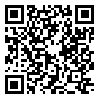Volume 4, Issue 7 (2017)
QHTS 2017, 4(7): 37-67 |
Back to browse issues page
Download citation:
BibTeX | RIS | EndNote | Medlars | ProCite | Reference Manager | RefWorks
Send citation to:



BibTeX | RIS | EndNote | Medlars | ProCite | Reference Manager | RefWorks
Send citation to:
heidary Z, hosseini H. Reviewing and criticizing the semantic types of the word "Nashata" in Persian translations of the Holy Quran. QHTS 2017; 4 (7) :37-67
URL: http://qhts.modares.ac.ir/article-10-1889-en.html
URL: http://qhts.modares.ac.ir/article-10-1889-en.html
1- faculty of Mashhad, Ferdowsi university
2- department science of Quran and hadis Mashhad
2- department science of Quran and hadis Mashhad
Abstract: (9483 Views)
The single-use vocabulary in comparison to other vocabulary in the Holy Qur'an requires more precision in translating, because there are no other explanatory options in other verses and this lack of the same verse has made it difficult for them to translate. The verb "Nashata" is one of the single-use vocabulary in the Holy Qur'an mentioned only in verse 2 of the surah "Nazeaat". It seems that the translators in dealing with this word have been made different types of translations and have different voices.The present paper aims at analyzing the data and choosing the best translation, by classifying the approaches of translators and analyzing the Qur'anic data, to examine and critique the semantic forms presented by them to answer finally to this question that which translation is eventually has more credibility and is more reliable?
The result of this study is as follows: The translators have used three methods (literal, loyal and interpretive) in the translation of this verse, but, in fact, no one has been succeeded in complying with all the rules contained in the truth of the word, and consequently, it is necessary to present a corresponding meaning to the truth of the word.
The result of this study is as follows: The translators have used three methods (literal, loyal and interpretive) in the translation of this verse, but, in fact, no one has been succeeded in complying with all the rules contained in the truth of the word, and consequently, it is necessary to present a corresponding meaning to the truth of the word.
Article Type: مقاله پژوهشی |
Received: 2017/05/2 | Accepted: 2017/08/27 | Published: 2017/09/5
Received: 2017/05/2 | Accepted: 2017/08/27 | Published: 2017/09/5
| Rights and permissions | |
 |
This work is licensed under a Creative Commons Attribution-NonCommercial 4.0 International License. |








